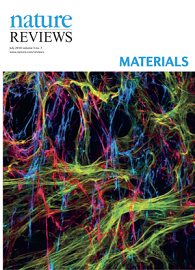Work of Badylak Lab Students Highlighted on Cover of Nature Review Materials
Stephen Badylak, DVM, PhD, MD, believes it’s “the best manuscript written to date on biologic scaffolds for regenerative medicine.”

McGowan Institute for Regenerative Medicine congratulates George Hussey, PhD, and Jenna Dziki, PhD student, on their newly published Nature Reviews Materials article entitled, “Extracellular matrix-based materials for regenerative medicine.” It is featured on the cover of the July 2018 issue of the journal with a 3D image of the matrix network by Visuals Unlimited, Inc./Dr. Edna Cukierman.
“They worked very hard putting together” what co-author and McGowan Institute for Regenerative Medicine deputy director Stephen Badylak, DVM, PhD, MD, believes is “the best manuscript written to date on biologic scaffolds for regenerative medicine. It will be highly cited in future years.”
Congratulations to all!
The abstract reads:
Illustration: The extracellular matrix is nature’s template for an ideal biomaterial to guide tissue homeostasis and repair. In this Review, matrix-mimicking biomaterials and decellularized matrices are discussed for their potential to reconstruct and repair tissues in vitro and in vivo. Image: Visuals Unlimited, Inc./Dr. Edna Cukierman.
Read more…
Bio: Dr. Stephen Badylak
Paper (Extracellular matrix-based materials for regenerative medicine. George S. Hussey, Jenna L. Dziki and Stephen F. Badylak. Nature Reviews Materials; on-line May 29, 2018.)
“They worked very hard putting together” what co-author and McGowan Institute for Regenerative Medicine deputy director Stephen Badylak, DVM, PhD, MD, believes is “the best manuscript written to date on biologic scaffolds for regenerative medicine. It will be highly cited in future years.”
Congratulations to all!
The abstract reads:
-
In tissue engineering and regenerative medicine, a biomaterial provides mechanical support and biochemical signals to encourage cell attachment and modulate cell behavior. Nature’s template for a biomaterial is the extracellular matrix (ECM). The ECM contains intrinsic biochemical and mechanical cues that regulate cell phenotype and function in development, in homeostasis and in response to injury. The use of ECM-based materials in biomedical research has advanced from coating cell culture plates with purified ECM components to the design of ECM-mimicking biomaterials and the engineering of decellularized tissues aimed at recapitulating the dynamics, composition and structure of the ECM. In this Review, we highlight important matrix properties and functions in the context of tissue engineering and regenerative medicine, consider techniques such as proteomics for the investigation of matrix structure and composition and discuss different engineering strategies for the design of matrix-mimicking biomaterials. Tissue, whole organ and cell culture decellularization approaches are examined for their potential to preserve the tissue-specific biochemical composition and ultrastructure of the ECM and for the development of biomaterials that promote the formation of functional tissues in clinical applications. Finally, we investigate challenges and opportunities of ECM biomaterials for the design of organotypic models to study disease progression, for the ex vivo creation of engineered tissue and for the clinical translation of functional tissue reconstruction strategies in vivo.
Illustration: The extracellular matrix is nature’s template for an ideal biomaterial to guide tissue homeostasis and repair. In this Review, matrix-mimicking biomaterials and decellularized matrices are discussed for their potential to reconstruct and repair tissues in vitro and in vivo. Image: Visuals Unlimited, Inc./Dr. Edna Cukierman.
Read more…
Bio: Dr. Stephen Badylak
Paper (Extracellular matrix-based materials for regenerative medicine. George S. Hussey, Jenna L. Dziki and Stephen F. Badylak. Nature Reviews Materials; on-line May 29, 2018.)
